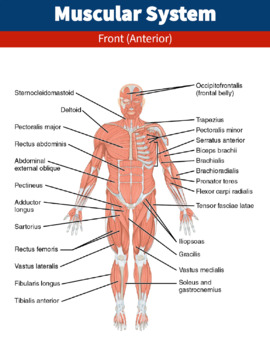Human Body Systems and Anatomy Printable Health Science Posters Classroom Decor
Learning Pyramid
875 Followers
Resource Type
Standards
NGSSMS-LS1-3
NGSSHS-LS1-2
Formats Included
- PDF
Pages
40 pages
Learning Pyramid
875 Followers
What educators are saying
The posters were a great resource. The kids really enjoyed looking at the different parts of the body in colorful posters.
Description
These printable posters make learning about human body systems easy and engaging! Use these posters to decorate a bulletin board or hallway display and reinforce your lessons! These posters are a perfect compliment to anatomy, biology, health, and science units and other materials.
You can print the standard posters on a heavier cardstock paper or laminate them to improve durability. These posters are provided in both full color and printer friendly black and white versions.
This printable poster set includes posters for the:
- Circulatory System
- Digestive System
- Nervous System and Parts of the Brain and Eye
- Respiratory System
- Muscular System
- Skeletal System
- Endocrine System
- Urinary System
- Lymphatic System
- Integumentary System
- Cardiovascular System
Also check out the Human Body Systems Worksheet and Handout Value Bundle for printable and digital companion worksheets and Easel activities!
Total Pages
40 pages
Answer Key
N/A
Teaching Duration
N/A
Report this resource to TPT
Reported resources will be reviewed by our team. Report this resource to let us know if this resource violates TPT’s content guidelines.
Standards
to see state-specific standards (only available in the US).
NGSSMS-LS1-3
Use argument supported by evidence for how the body is a system of interacting subsystems composed of groups of cells. Emphasis is on the conceptual understanding that cells form tissues and tissues form organs specialized for particular body functions. Examples could include the interaction of subsystems within a system and the normal functioning of those systems. Assessment does not include the mechanism of one body system independent of others. Assessment is limited to the circulatory, excretory, digestive, respiratory, muscular, and nervous systems.
NGSSHS-LS1-2
Develop and use a model to illustrate the hierarchical organization of interacting systems that provide specific functions within multicellular organisms. Emphasis is on functions at the organism system level such as nutrient uptake, water delivery, and organism movement in response to neural stimuli. An example of an interacting system could be an artery depending on the proper function of elastic tissue and smooth muscle to regulate and deliver the proper amount of blood within the circulatory system. Assessment does not include interactions and functions at the molecular or chemical reaction level.





